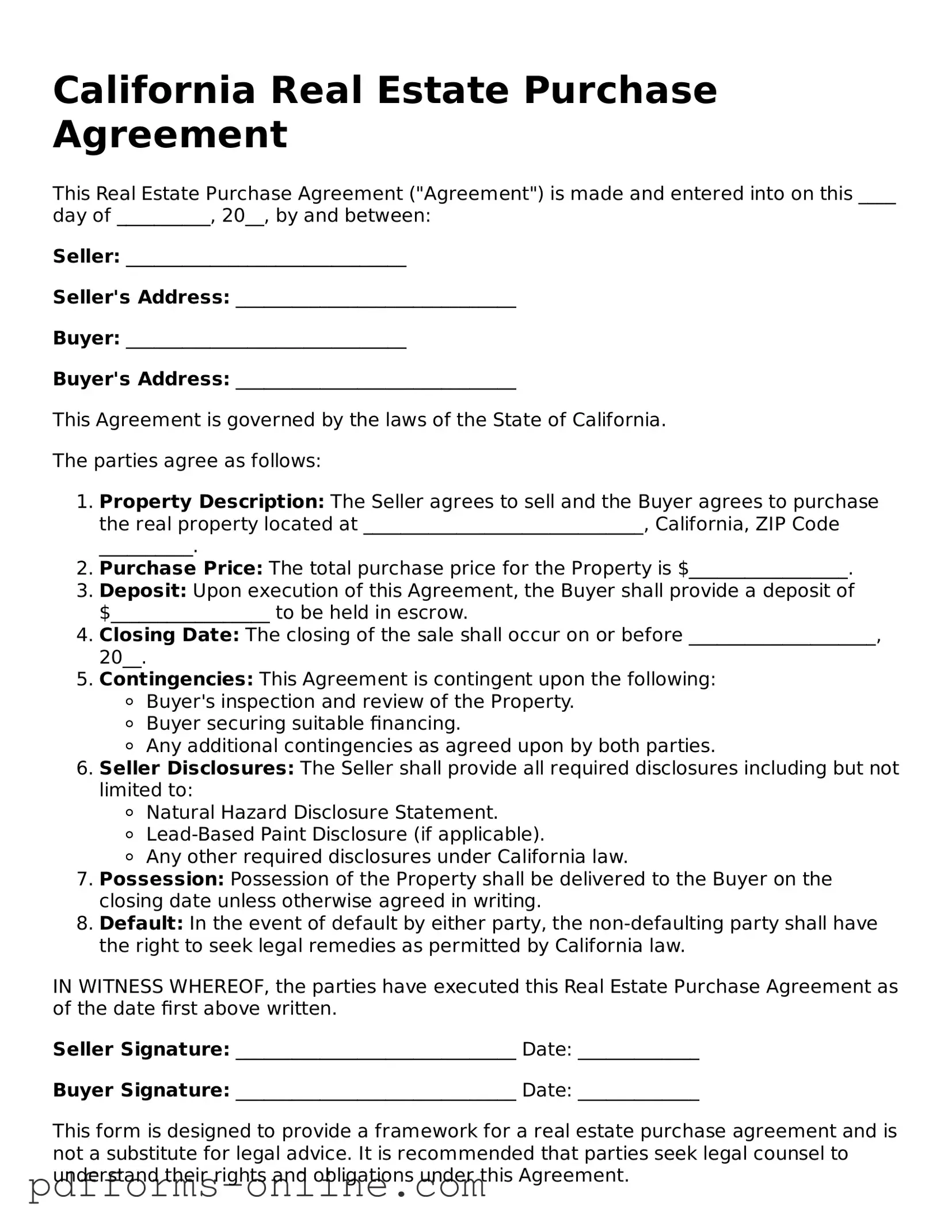The California Residential Purchase Agreement is similar to the Residential Lease Agreement. Both documents outline the terms and conditions under which a property is rented or sold. They include details such as the parties involved, property description, and payment terms. While the lease agreement focuses on rental terms, the purchase agreement centers on the sale of the property, making it essential for buyers and sellers to understand the differences in their legal implications.
The Commercial Real Estate Purchase Agreement shares similarities with the California Residential Purchase Agreement in that both serve as binding contracts for property transactions. Each agreement specifies the purchase price, contingencies, and closing procedures. However, the commercial version often includes additional clauses related to zoning laws, business operations, and lease agreements, reflecting the complexities of commercial property transactions.
The Option to Purchase Agreement is another document akin to the California Residential Purchase Agreement. This agreement grants a potential buyer the right to purchase a property at a predetermined price within a specified time frame. Like the purchase agreement, it outlines the terms of the transaction but focuses on the option rather than an outright sale, allowing flexibility for the buyer.
The Seller Financing Agreement is similar in that it facilitates the sale of real estate, but it specifically details the terms under which the seller provides financing to the buyer. Both documents cover payment terms and interest rates, but the seller financing agreement includes provisions regarding default and remedies, which are crucial for protecting the seller's interests.
The Land Contract, also known as a Contract for Deed, resembles the California Residential Purchase Agreement in that it allows a buyer to make payments directly to the seller over time. Both documents outline the purchase price and payment schedule. However, the land contract allows the seller to retain legal title until the buyer completes all payments, which adds a layer of protection for the seller.
The Exclusive Listing Agreement is similar in that it involves the sale of real estate, but it focuses on the relationship between the seller and the real estate agent. It outlines the agent's responsibilities and the commission structure. While the purchase agreement finalizes the sale, the listing agreement sets the stage for the sale process, ensuring both parties understand their roles.
The Buyer Representation Agreement is another document that aligns with the California Residential Purchase Agreement. This agreement establishes a relationship between the buyer and their real estate agent, detailing the agent's duties to represent the buyer's interests. Both agreements are crucial in the real estate transaction process, but the buyer representation agreement emphasizes the agent's role in finding and negotiating the purchase of a property.
The Addendum to Purchase Agreement serves as an extension of the California Residential Purchase Agreement. It provides additional terms or conditions that may arise during the negotiation process. Like the purchase agreement, it is legally binding and must be agreed upon by both parties. This document allows for flexibility in addressing specific concerns that may not be covered in the main agreement.
The Access-A-Ride NYC Application form is essential for employees looking to participate in the City of New York Commuter Benefits Program, specifically for Access-A-Ride and other paratransit options. This form not only guides users in submitting their completed applications but also outlines necessary documentation, emphasizing the importance of pre-tax benefits based on eligibility. Participants can use this application for enrollment, updating personal information, adjusting deductions, and even cancellation, ensuring their commuting requirements are satisfied through the MTA New York City Transit Access-A-Ride Program or other supported services. For further assistance, you can download it here.
The Real Estate Disclosure Statement is similar in that it provides essential information regarding the property being sold. While the purchase agreement outlines the transaction terms, the disclosure statement ensures that buyers are aware of any issues, such as environmental hazards or structural problems. This transparency is vital for informed decision-making and helps protect both parties during the sale.
The Purchase and Sale Agreement is closely related to the California Residential Purchase Agreement, as both documents serve to finalize the sale of real estate. They detail the terms of the sale, including price, contingencies, and closing dates. The primary difference lies in the terminology and regional variations, but both agreements fulfill the same purpose of documenting the sale transaction.
